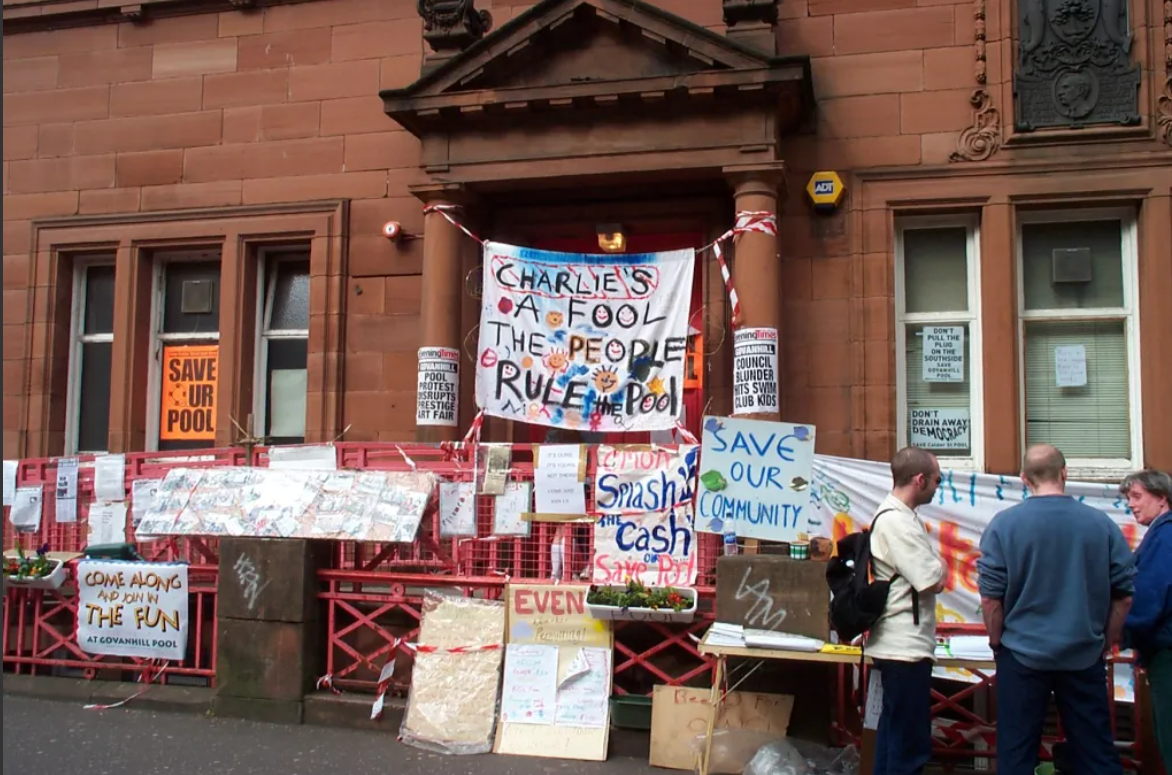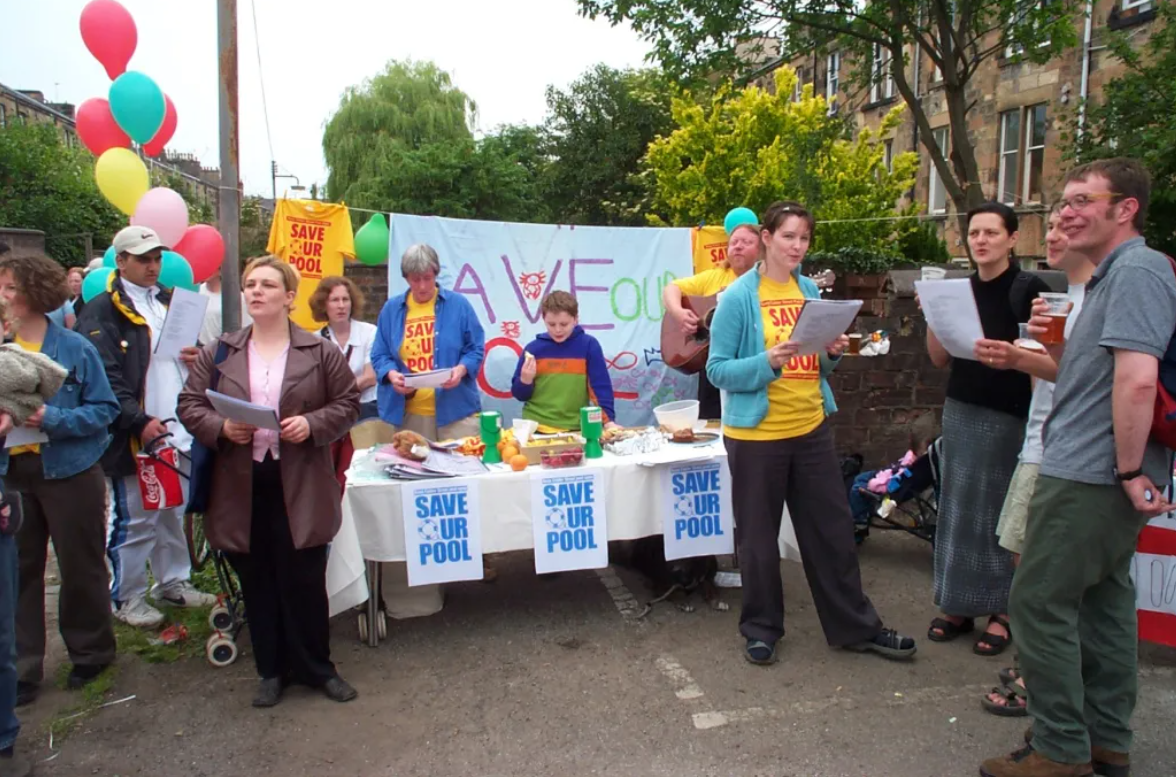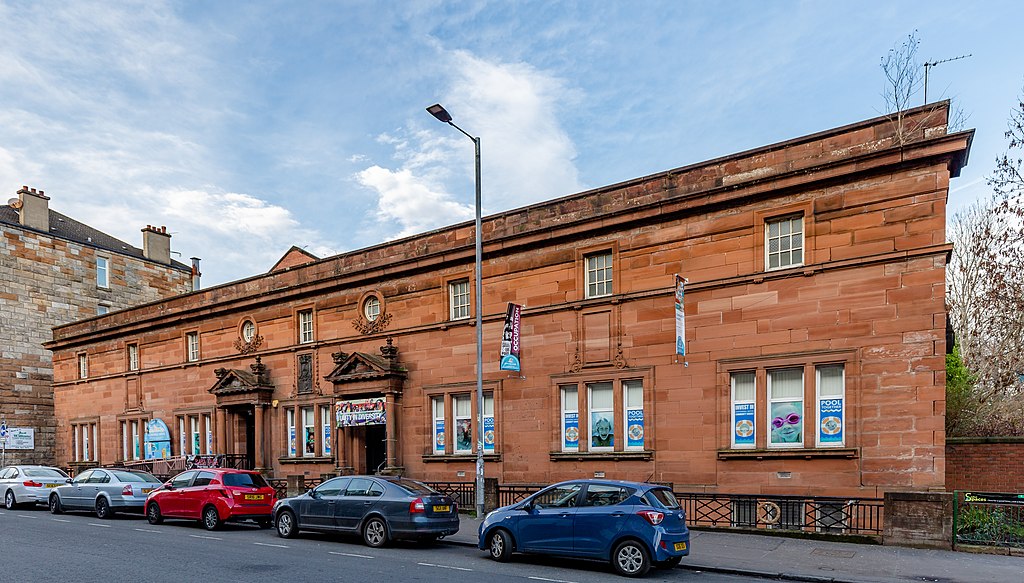This article belongs to the Women and Workplace Struggles: Scotland 1900-2022 collection.

Background
In March 2001, Glasgow City Council decided to close what was to many residents in the heart of Glasgow’s Southside, the famous historic baths and washhouse in Calder Street, Govanhill, against the wishes of the local community. A small group of local people attended the final evening session before closure and refused to leave. This began what is still the longest continuous occupation of a civic building in British history, lasting some 141 days. Over twenty years later in 2022, the building is being refurbished to re-open as a Wellbeing Centre including restoration of the historic “Ladies Pool”. Since the announcement of the Council’s intention to close the facility, to today’s anchor community organisation, Govanhill Baths Community Trust (GBCT), women have been at the forefront of the campaign.
The Importance of the Baths to the Govanhill Community
Govanhill Baths had three swimming pools, one of which was exclusively for women. On certain nights of the week, the whole facility, including the main pool and Turkish baths, were women-only. This meant that, to many local women, Govanhill Baths was a meeting place, a socialising place, a woman's space and more than just for swimming.
The laundry, or “Steamie”, at the back of the building had closed years earlier but from its inception, and for almost a century, it too had also been very much a woman’s space. So, when the community reacted to the closure, it was often women who were most connected to the building and they stepped forward to fight to save it. They were joined by women involved with the local swimming clubs, who took their children to Calder Street every week; by local Primary School teachers, female political activists, by women of colour who understood that there was no other facility they could use, and locals who felt that their voices were not being heard.
People like Cath Sinclair, who had four children who had learned to swim there and were part of the in-house Kingston Swimming Club, a club with a proud history of teaching thousands of working-class children swimming for almost 100 years; Nicola Fisher, a local teacher who lived on Calder Street who had used the slipper baths for a hot bath for many years before internal bathrooms were installed into her tenement; Jean Adair, a daily swimmer and receptionist at the local Health Centre who attended the pool twice weekly for over 30 year with her disabled best friend, Margaret, a wheelchair user who enjoyed the easy access to the main pool and showers; Nessa Mechan, the local “provy wummin” and popular local campaigner who knew first hand that ordinary people did not have the means or ability to travel miles to an alternative facility; Frances Diver, local art teacher whose whole family used the baths; Zamara Zahid, a local teacher and Black rights activist who knew the importance of a safe, culturally sensitive facility for Muslim women to engage in sporting and wellbeing activities.
These women were joined by many other women from Govanhill and beyond, and they came to lead the campaign. Supported by the Scottish National Party MSP for the area, Nicola Sturgeon, then a young and rising politician, and later Scottish First Minister, and the experienced politician Dorothy Grace-Elder, then SNP MP for the area.
Occupying the Govanhill Pool Building
The occupation itself would last for five months, ending in August 2001. The occupation inside the building, and the picket line outside of the building, over those months was very much led and inspired by the local women, notably Dr Bernie Milligan, Geraldine Sinkie, Rae McKindlay, Meena Kashore and Judith Fryer. These were women who either used the facility on women's nights and/or their children used the facility. Women who knew the closure would likely have a negative effect on the health of families and a devastating effect on their community. Women who felt ownership of the Baths, whose parents and grandparents used the facility.

In the years following the closure, the GBCT was formed to try to prevent the building being demolished and, eventually, developed a plan to take over the building on behalf of the community. This Trust and its emerging community programme of initiatives and activities, brought more women into the campaign, people like Nadine Gorency, who formed the GBCT offshoot Rags To Riches, one of Scotland’s leading community-led environmental projects; artist Alex Wilde, who is now the Chair of the Trust, and Dr Heather Lynch who played a key role in enabling these women and others from the community to get back into the building in 2012 and helped establish a community Wellbeing Programme which has become the flagship project for the Trust.
Looking Ahead
Looking back from the vantage point of mid-2022, it is evident that the various community programmes that have been launched over the years have flourished. The Community Trust now delivers A Peoples Pantry, Wellbeing Programme, Community Archives, Rags to Riches, Youth Project, Govanhill Baths Arts Programme, DeepEnd Arts Space and a Community Action Programme. All but two are managed by women, most from the immediate locality.

Govanhill Baths is now far more than a swimming facility, important that this is. The project has grown to become a wide-reaching anchor organisation in the Govanhill area, as well as across the wider Southside of Glasgow. Throughout this development, women have played leading roles and have been to the fore driving the community organising. They have been committed to ambitious practices and goals, goals that challenge existing structures and shift agency to the community. Women who ensure that equality, diversity and inclusion is at the core of the diverse range of activities and projects that come under the Govanhill Baths umbrella, as well as ensuring that these values inform the development of further initiatives as well as ambitions for the future.
For over twenty years the development of the project has been informed by bringing people together to advance change, to challenge injustices and to oppose all forms of discrimination – as well as supporting others in doing so. This involves listening to and respecting people who face daily struggles as well as structural discrimination, while working to challenge those attitudes, systems and practices.
Two decades and more of community struggle has led to the re-opening of a greatly refurbished Govanhill Baths in 2022. The opening of a revitalised £9.5m community facility is entirely down to the engagement and actions of everyone who was involved in the campaign, not least the women of Govanhill.
United We Will Swim! Interview with Fatima Uygun
In early 2022 Thora Hands from The Open University interviewed Fatima Uygun about her involvement in the struggle to re-open Govanhill Baths. This can be accessed below:




Rate and Review
Rate this article
Review this article
Log into OpenLearn to leave reviews and join in the conversation.
Article reviews